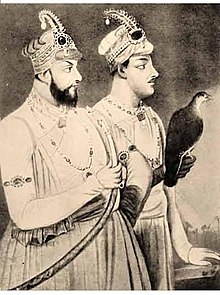Mir Jafar
Mir Muhammed Jafar Ali Khan, formal title Shuja-ul-Mulk, Hashim ud-Daula, Nawab Ja'afar Ali Khan Bahadur, Mahabat Jang commonly known as Mir Jafar, second son of Sayyid Ahmad Najafi, (1691–February 5, 1765) was Nawab of Bengal, Bihar and Orissa.
He is also known by Indians as Gaddar-e-Abrar (which translates in English as 'The Traitor of Faith'). He succeeded Siraj-Ud-Daulah as the eighth Nawab of Bengal, and the first of the Najafi dynasty after deceiving Nawab Siraj-Ud-Daulah and surrendering his army in battle field against Robert Clive. His rule is widely considered the start of British rule in India and was a key step in eventual British domination of the country. His lust to become Nawab of Bengal led him to make a secret pact with Robert Clive and surrender & slaughter the Army of Bengal in the Battle of Plassey, without fighting, which led to foundation of British rule in India. For his act of treachery, in Bengali, the word 'Mir Jafar' is now synonym for 'Traitor' and he has been infamously called Gaddar-e-Abrar ("Betrayer of the true Faith") in hindi and urdu.
Allama Iqbal had written poetry on him,
"Mir Jafar o bengal Mir sadiq o deccan nange deen, nange adam, nange watan"
which mean Mir Jafar of Bengal and Mir Sadiq of Deccan are disgrace to the faith, disgrace to humanity, disgrace to the nation.
Mir Jafar had set an example that an individuals greed can bring an entire nation to slavery and hardship. British with the help of Mir Jafar and Mir Sadiq were able to conquer Bengal and kingdom of Mysore (Sultanat-e-Khuda daad).
....................................................................................................................................................................
Syud Mir Muhammed Jafar Ali Khan, formal title 'Shuja ul-Mulk, Hashim ud-Daulla, Nawab Ja'afar Ali Khan Bahadur, Mahabat Jang (Hero of the Country, Sword of the State, Horror in War)' commonly known as Mir Jafar, belonged to the Syud dynasty.
Hazrat Ali, the son-in-law of Hazrat Muhammad (PBUH), was the 30 th predecessor of Mir Jafar. Hazrat Ali buried in Iraq. Mir Jafar's fathers name was Syud Ahmed Najafi and his grandfather's name was Syud Hussain Najafi. Mir Jafar's grandfather Syud Hussain Najafi was the caretaker of the world famous fabulously decorated mausoleum of Hazrat Ali.
In 1677 AD Aurangzeb went to Mecca on pilgrimage and met Hussain Najafi. Aurangzeb was impressed seeing his depth of knowledge and personality; and brought him to Delhi, appointing him as Kazi-a-Koajud (Chief Justice of Supreme Court).
Ahmed Najafi married the daughter of Dara who was the elder brother of Aurangzeb (captured and killed by Aurangzeb), and their son was Mir Jafar. Dara's wife was the daughter of Rana Jaswant Singh of Chitore. Mir Jafar married Shah khanum the niece of Alivardi Khan, and their elder son was Miran. Alivardi raised Mir Jafar to the post of bakhshi, a position next only to the nawab himself.
Mir Jafar married (first) at Murshidabad on 1727, Shah Khanum Sahiba (half-sister of Nawab Alivardi Khan and daughter of Shah Quli Khan [Mirza Muhammad Madani]). She died at Jafarganj Palace, Murshidabad on August 1779 and was burried at Jafarganj Cemetery. Married (second) H.H. Babbu Begum Sahiba (Gaddinashin Begum) daughter of Sammen Ali Khan by Bisu. She died at Murshidabad in 1809, burried at Jafarganj Cemetery. Married (third) in 1746, H.H. Munny Begum Sahiba, a former dancing girl in the household of Sammen Ali Khan. (she died at Murshidabad on 10 th January 1813, burried at Jafarganj Cemetery). He also had Mut'ah wife Rahat-un-nisa begum. Mir Jafar had six sons and six daughters.
| Mir Jafar Ali Khan | |
|---|---|
| Shuja ul-Mulk, Hashim ud-Daula, Nawab Ja'afar 'Ali Khan Bahadur, Mahabat Jang, Nawab of Bengal, Bihar and Orissa | |
 Mir Jafar (left) and one of his sons, Mir Miran (right). |
|
| Reign | 1757–1765 |
| Full name | Mir Muhammed Jafar Ali Khan |
| Born | 1691 |
| Died | February 5, 1765 |
| Predecessor | Siraj-ud-Daulah |
| Successor | Mir Qasim, Najimuddin Ali Khan |
| Consort to | Munny Begum (d. January 10, 1813) and Babbu Begum (d. 1809) |
| Wives | Shah Khanam Muni Begum |
| Offspring | Najimuddin Ali Khan Najabut Ali Khan Ashraf Ali Khan Mubaraq Ali Khan |
| Dynasty | Najafi |
| Father | Sayyid Ahmad Najafi |
| Religious beliefs | |
